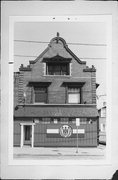Property Record
1024 E BRADY ST
Architecture and History Inventory
| Historic Name: | Hambach & Hellmann Meat Store |
|---|---|
| Other Name: | Glorioso's |
| Contributing: | Yes |
| Reference Number: | 98945 |
| Location (Address): | 1024 E BRADY ST |
|---|---|
| County: | Milwaukee |
| City: | Milwaukee |
| Township/Village: | |
| Unincorporated Community: | |
| Town: | |
| Range: | |
| Direction: | |
| Section: | |
| Quarter Section: | |
| Quarter/Quarter Section: |
| Year Built: | 1910 |
|---|---|
| Additions: | |
| Survey Date: | 1986 |
| Historic Use: | retail building |
| Architectural Style: | German Renaissance Revival |
| Structural System: | |
| Wall Material: | Brick |
| Architect: | Theodore Schutz |
| Other Buildings On Site: | |
| Demolished?: | No |
| Demolished Date: |
| National/State Register Listing Name: | East Brady Street Historic District |
|---|---|
| National Register Listing Date: | 3/9/1990 |
| State Register Listing Date: | 2/1/1990 |
| National Register Multiple Property Name: |
| Additional Information: | "During the early part of this century, the Hambach and Hellmann Meat Store was one of over 200 small butcher shops scattered throughout the city. The quality design of the Hambach and Hellmann building, which is a fine example of of the German Renaissance Revival style of architecture, reflects the importance of its site as a good location for business at the turn of the century. Like much of the city's ethnic architecture, this store was built for members of Milwaukee's burgeoning German-American community. The mason contractor, Anton Schmidt, as well as the architect and the original owners were all of German-American heritage. Standing out as it does among the surrounding American Victorian style and plain early 20th century commercial structures, the distinctive, ethnic-inspired architecture of the building served as an excellent advertisement for the business. Structures such as the Hambach and Hellmann store were a visual link to "Old World" traditions and culture which many German-American immigrants and their descendants remembered with admiration and pride. The street-level storefront has been greatly altered over the years, but the upper part of the building remains virtually unchanged. The end of the finely shaped front gable have a "stepped" appearance, which is characteristic of building traditions in Germany, while the ornamental coping that edges the top of the gable is a bold Tuetonic touch. The use of knife-thin mortar joints between the sienna-colored bricks is one of the building techniques favored by German builders around the turn of the century because it produced a very fine finished appearance, even though doing it was costly and required extra labor and the use of more brick than would have been the case with wider mortar joints. The unusual leaded glass in the windows on the second story is of American Prairie style design, which was very fashionable during the first two decades of this century. During the late 19th century, Brady Street was considered to be the main street of the city's east side Polish community. At that time, most of the merchants in the area were of Polish descent, bu there were also a number of German merchants such as William F. Hellmann and his partner, Frederick Hambach, Jr. The Hambach family was well known in the city's retail most trade at the turn of the century because they operated four butcher shops around the city. About 1918 the partnership dissolved and Hellmann continued the business on his own. Like most shopkeepers of his era, Hellmannn lived in the flat above the store. In 1920 Hellmann sold his business to a Polish-American businessman, Benjamin D. Jaworski, who continued to operate the butcher shop in the 1930s. Hellman and his wife, Adele, lived in the upper flat until the mid-1920s when they moved to the city's West Side where Hellmann worked as a meat cutter. Hellmann apparently never went back into business for himself. Between the late 1930s to the late 1960s, the building housed a variety of different businesses, none of which was a meat store. Since the late 1960s, however, the building has been the home of Glorioso's Market, a well-known delicatessen and butcher shop. It is again filled with the aromas of sausages, herbs, and cooking spices mush as it was during its heyday more than 80 years ago. The Hambach and Hellmann Meat Store is located within the Brady Street Historic District which has both Local and National Register Designation." MILWAUKEE ETHNIC COMMERCIAL AND PUBLIC BUILDINGS TOUR, CITY OF MILWAUKEE DEPARTMENT OF CITY DEVELOPMENT, 9/1994. |
|---|---|
| Bibliographic References: | MILWAUKEE ETHNIC COMMERCIAL AND PUBLIC BUILDINGS TOUR, CITY OF MILWAUKEE DEPARTMENT OF CITY DEVELOPMENT, 9/1994. |
| Wisconsin Architecture and History Inventory, State Historic Preservation Office, Wisconsin Historical Society, Madison, Wisconsin |

